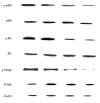Lysine-Specific Demethylase 1 (LSD1) Inhibitor S2101 Induces Autophagy via the AKT/mTOR Pathway in SKOV3 Ovarian Cancer Cells
- PMID: 27914215
- PMCID: PMC5142589
- DOI: 10.12659/msm.898825
Lysine-Specific Demethylase 1 (LSD1) Inhibitor S2101 Induces Autophagy via the AKT/mTOR Pathway in SKOV3 Ovarian Cancer Cells
Abstract
BACKGROUND S2101 is one of the most potent LSD1 inhibitors, which can inhibit ovarian cancer cells viability. This study aimed to detect the mechanism behind the anticancer properties of S2101 in SKOV3 ovarian cells. MATERIAL AND METHODS Cell viability was tested by Cell Counting Kit-8 (CCK-8) assay. Cellular apoptosis and autophagy were evaluated by flow cytometric analysis using Annexin-V/PI staining methods and Green fluorescent protein (GFP)-fused-LC3 (GFP-LC3), respectively. Western blotting was performed for analyzing the Bax, Bcl-2, mTOR, p- mTOR, p62, LC3-I, LC3-II, AKT, and p-AKT protein expression. RESULTS Our results show that the proportion of early apoptotic and late apoptotic cells increased significantly for cells treated with S2101 at a concentration of 100 μM for 48 h. Treatment of S2101 in SKOV3 cells resulted in upregulation of Bax and downregulation of Bcl-2 in a time-dependent manner, indicating that S2101 can induce apoptosis in SKOV3. There was a downward trend in the expression of p62 when the SKOV3cells were treated with 100 µm S2101 for 12 h, 24 h and 48 h. The conversion of LC3-I to LC3-II was increased significantly at 24 h and 48 h. Autophagy was induced by S2101 in SKOV3 cells, evidenced by an increase in punctuate localization of GFP-LC3 and a change in expression of autophagy-related proteins. CONCLUSIONS S2101 treatment decreased the levels of phosphorylated AKT and mTOR. S2101 inhibits SKOV3 cells viability and induces apoptosis and autophagy. The AKT/mTOR signaling pathway was found to be affected by S2101.
Conflict of interest statement
The authors declare that there is no conflict of interest.
Figures




Similar articles
-
Endoplasmic reticulum stress promotes autophagy and apoptosis and reverses chemoresistance in human ovarian cancer cells.Oncotarget. 2017 Jul 25;8(30):49380-49394. doi: 10.18632/oncotarget.17673. Oncotarget. 2017. PMID: 28537902 Free PMC article.
-
Orlistat induces apoptosis and protective autophagy in ovarian cancer cells: involvement of Akt-mTOR-mediated signaling pathway.Arch Gynecol Obstet. 2018 Sep;298(3):597-605. doi: 10.1007/s00404-018-4841-2. Epub 2018 Jul 4. Arch Gynecol Obstet. 2018. PMID: 29974191
-
Grifolin induces autophagic cell death by inhibiting the Akt/mTOR/S6K pathway in human ovarian cancer cells.Oncol Rep. 2016 Aug;36(2):1041-7. doi: 10.3892/or.2016.4840. Epub 2016 May 30. Oncol Rep. 2016. PMID: 27277722
-
Prucalopride Inhibits Proliferation of Ovarian Cancer Cells via Phosphatidylinositol 3-Kinase (PI3K) Signaling Pathway.Med Sci Monit. 2018 Jun 17;24:4137-4145. doi: 10.12659/MSM.907853. Med Sci Monit. 2018. PMID: 29909423 Free PMC article.
-
DHA2, a synthesized derivative of bisbibenzyl, exerts antitumor activity against ovarian cancer through inhibition of XIAP and Akt/mTOR pathway.Food Chem Toxicol. 2014 Jul;69:163-74. doi: 10.1016/j.fct.2014.04.010. Epub 2014 Apr 18. Food Chem Toxicol. 2014. PMID: 24751974
Cited by
-
Understanding and Targeting Apoptotic Pathways in Ovarian Cancer.Cancers (Basel). 2019 Oct 24;11(11):1631. doi: 10.3390/cancers11111631. Cancers (Basel). 2019. PMID: 31652965 Free PMC article. Review.
-
Lysine-specific demethylase 1 inhibition enhances autophagy and attenuates early-stage post-spinal cord injury apoptosis.Cell Death Discov. 2021 Apr 6;7(1):69. doi: 10.1038/s41420-021-00455-7. Cell Death Discov. 2021. PMID: 33824301 Free PMC article.
-
Lysine-specific demethylase 1 (LSD1) destabilizes p62 and inhibits autophagy in gynecologic malignancies.Oncotarget. 2017 Aug 10;8(43):74434-74450. doi: 10.18632/oncotarget.20158. eCollection 2017 Sep 26. Oncotarget. 2017. PMID: 29088798 Free PMC article.
-
HDAC1-mediated deacetylation of LSD1 regulates vascular calcification by promoting autophagy in chronic renal failure.J Cell Mol Med. 2020 Aug;24(15):8636-8649. doi: 10.1111/jcmm.15494. Epub 2020 Jun 28. J Cell Mol Med. 2020. PMID: 32596952 Free PMC article.
-
Histone demethylases in autophagy and inflammation.Cell Commun Signal. 2025 Jan 13;23(1):24. doi: 10.1186/s12964-024-02006-w. Cell Commun Signal. 2025. PMID: 39806430 Free PMC article. Review.
References
-
- Siegel RL, Miller KD, Jemal A. Cancer statistics. Cancer J Clin. 2015;65:5–29. - PubMed
-
- Guarneri V, Piacentini F, Barbieri E, Conte PF. Achievements and unmet needs in the management of advanced ovarian cancer. Gynecol Oncol. 2010;117:152–58. - PubMed
-
- Metzger E, Imhof A, Patel D, et al. Phosphorylation of histone H3T6 by PKCbeta(I) controls demethylation at histone H3K4. Nature. 2010;464:792–96. - PubMed
-
- Metzger E, Wissmann M, Yin N, et al. LSD1 demethylates repressive histone marks to promote androgen-receptor-dependent transcription. Nature. 2005;437:436–39. - PubMed
MeSH terms
Substances
LinkOut - more resources
Full Text Sources
Other Literature Sources
Medical
Research Materials
Miscellaneous

